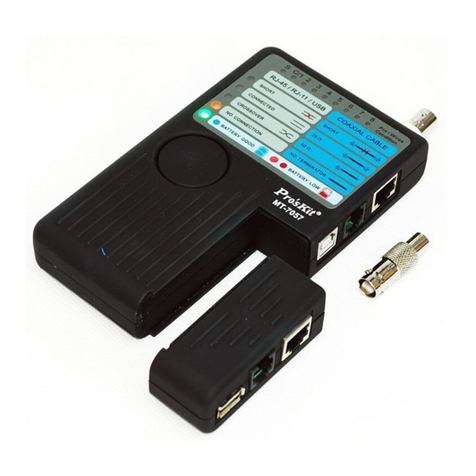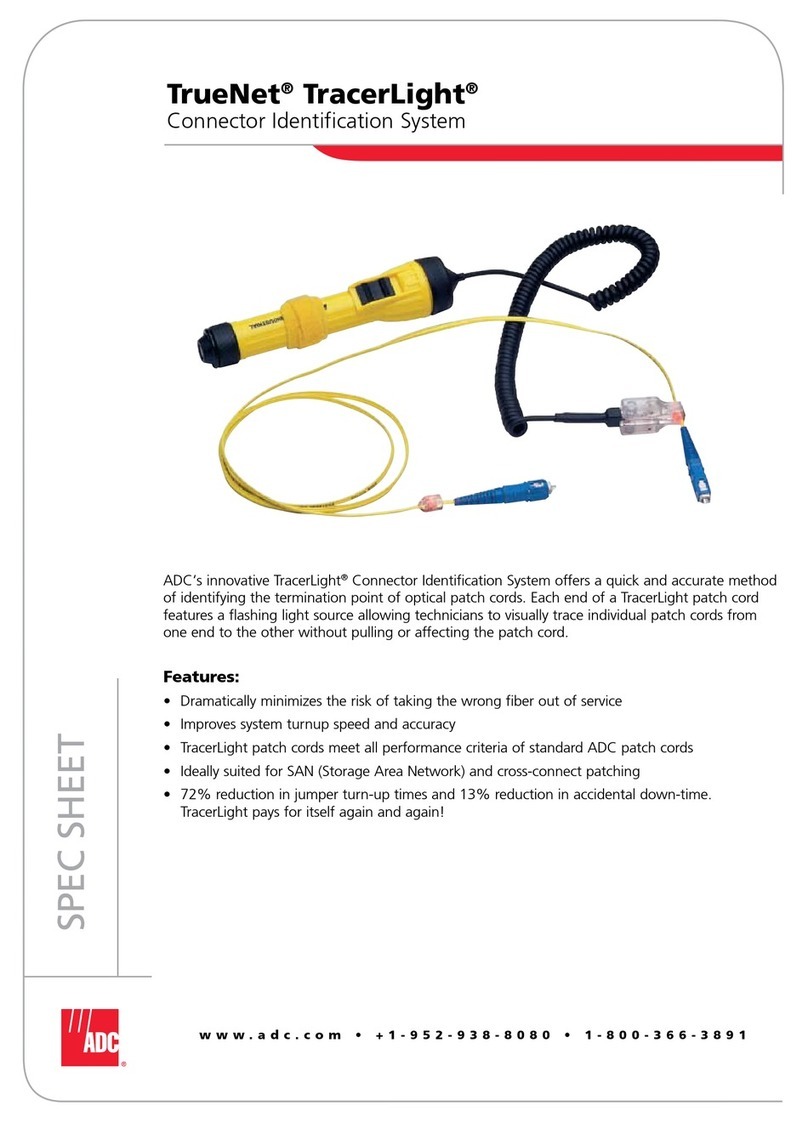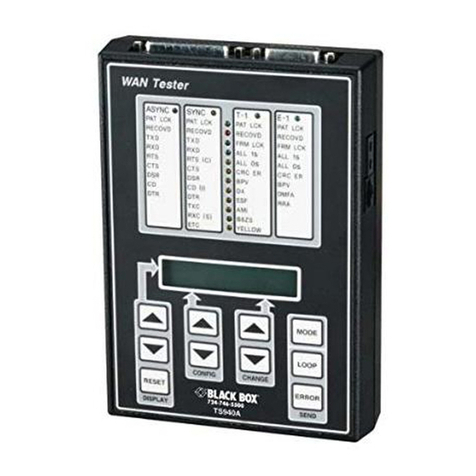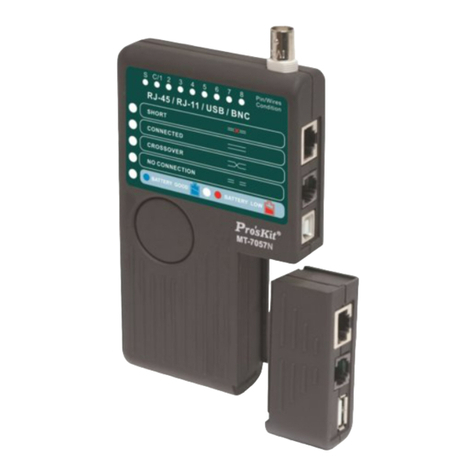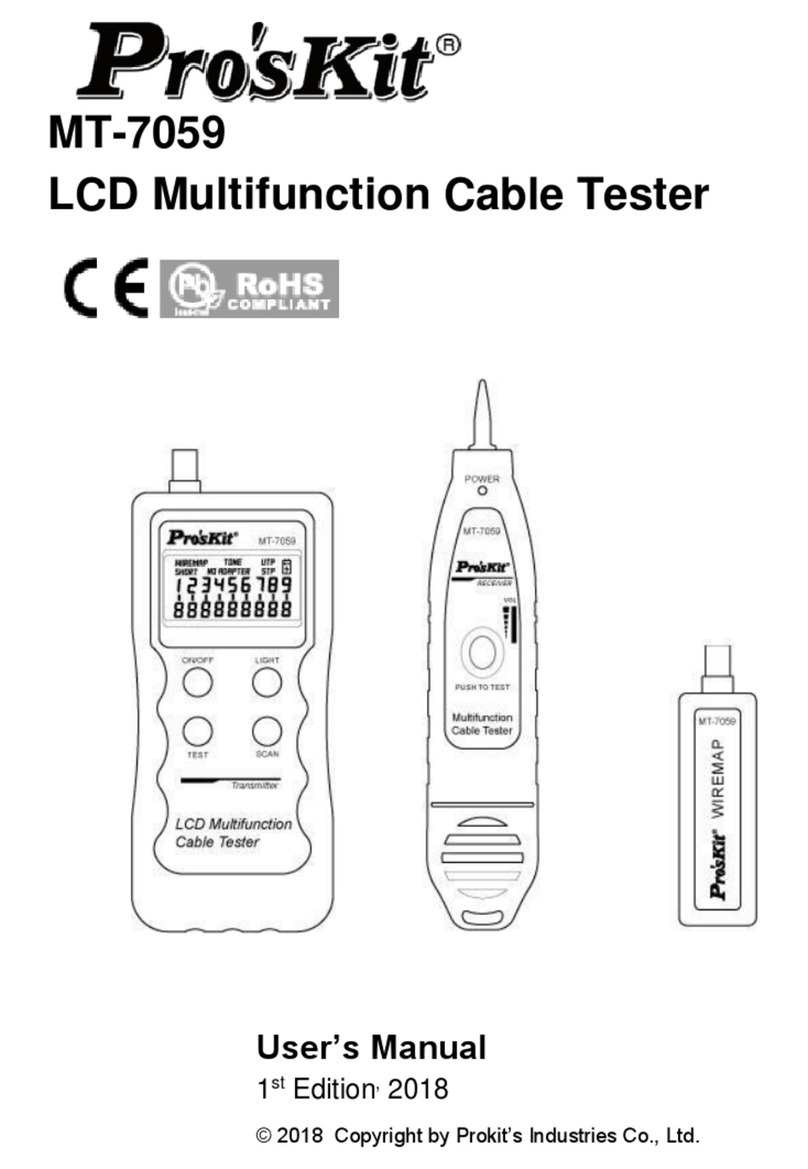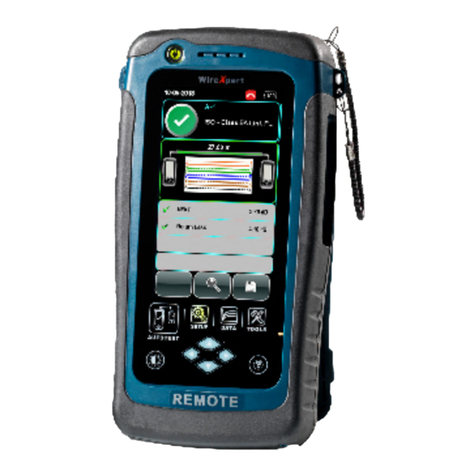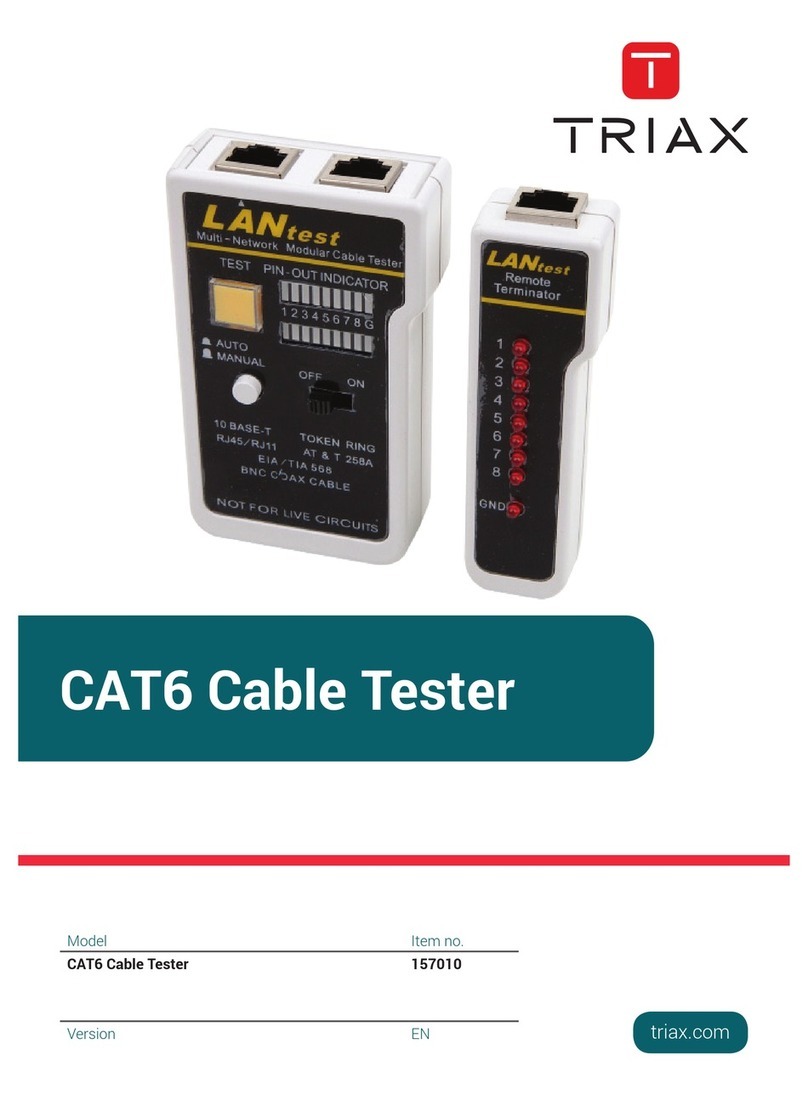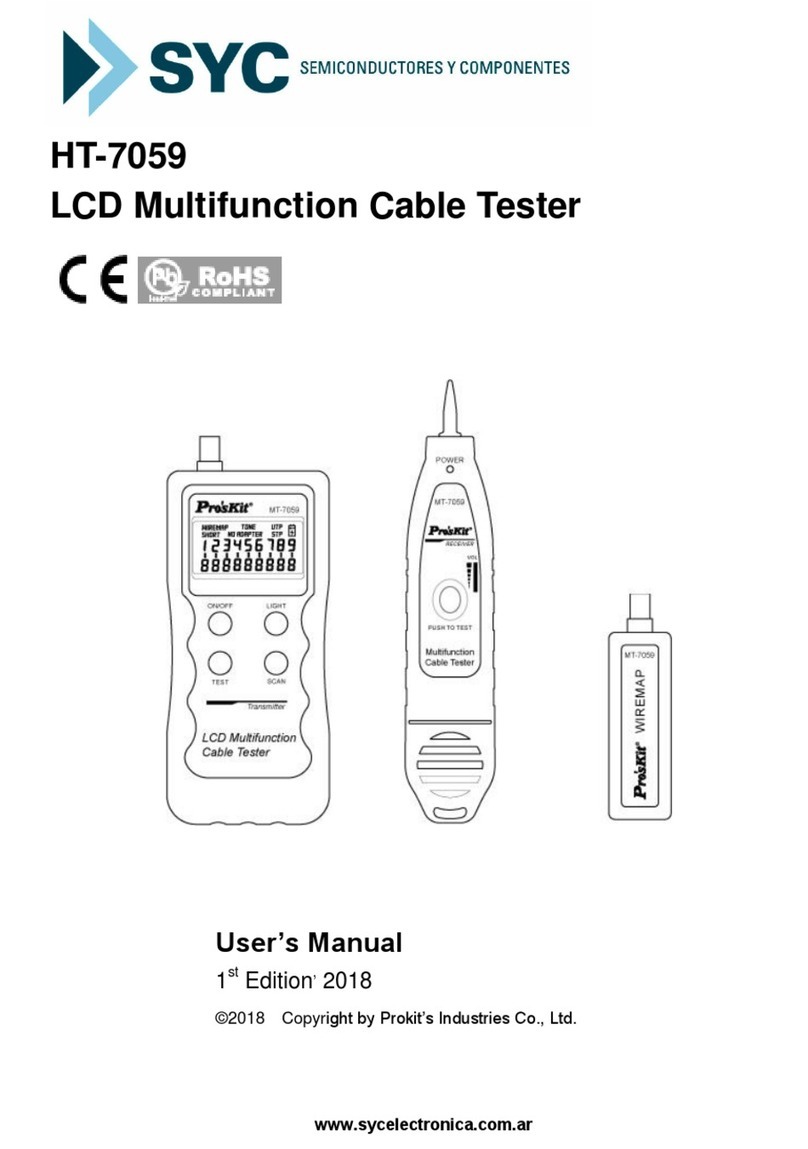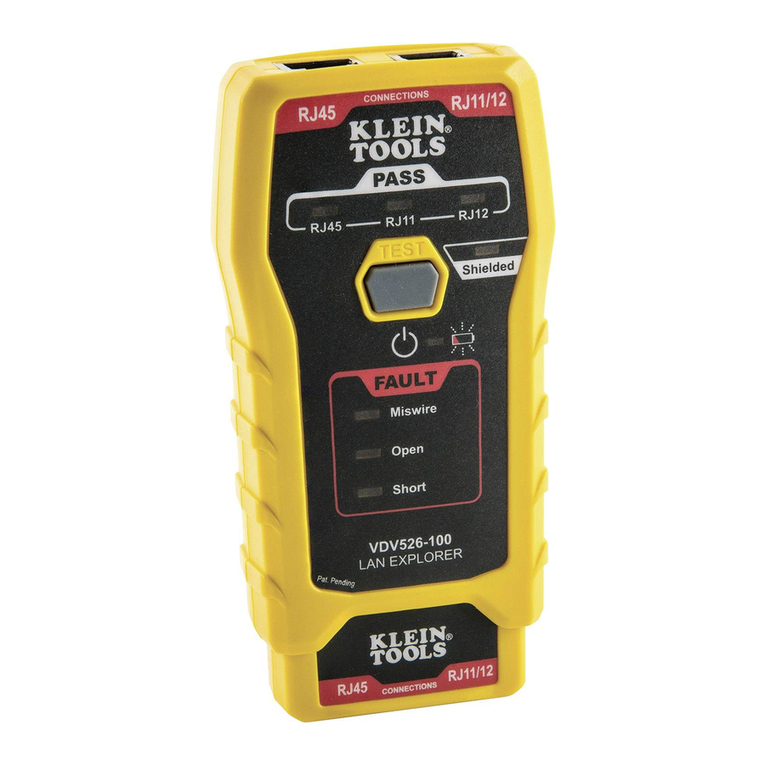Socket & See PDL Series User manual

PDL 200A/PDL 234 SERIES
MULTIFUNCTION ELECTRICAL TESTERS
Tests no-trip loop, socket, mains voltage & polarity
PDL SERIES
USER MANUAL 06/06

2
Caution
We strongly advise reading and understanding this guide
before the instrument is used. In particular note the safety
issues that follow:-
l Although fully protected up to 600V AC this tester is for
use on 230V AC circuits only
l Always check the tester on a known correctly wired live
socket outlet before and after use.
l The loop test notes given on page 8 are for guidance only
- full reference to the IEE Wiring Regulations must be made.
l Before use - check your tester for any damage to the plug,
leads and cabinet.
At Socket & See our Engineers constantly look for improvement.
If there is any aspect of your Socket & See tester you would like
to comment on please visit our website at
www.socketandsee.co.uk
with any suggestions.
We promise all communications will be acknowledged.
We value YOUR opinion.
BS EN
61010-1
PDL Series

3
Operation overview
Your Socket & See tester has a special polarity test function.
It is a little known fact that a system can be reverse wired with Live (Phase) to
earth/neutral and earth/neutral to Live (Phase) The sockets will all work and
conventional loop testers will show and test that everything is correct despite
this very dangerous wiring condition.
Although extremely rare, this miswire condition can exist so if your test shows
this fault do not proceed - if in any doubt advise your customer to contact their
supply company immediately.
FUSE 100A
FUSE 100A
From Supply
Company Live (Phase)
to Meter
Neutral to Meter
To Main
Earthing
Terminal
Neutral to Meter
Live (Phase)
to Meter
To Main
Earthing
Terminal
From Supply
Company
Correct Polarity
REVERSE POLARITY
Typical Supply Service
Cut-Out Fuse
LIVE (Phase)
NEUTRAL
Typical Supply Service
Cut-Out Fuse
NEUTRAL
LIVE (Phase)
Solid Brass
Connecting
Block
Solid Brass
Connecting
Block

4
PDL Series
Operation overview continued
The PDL 200A and PDL 234 are multifunction testers, testing no-trip loop,
mains voltage, correct socket wiring and polarity.
Correct socket wiring and correct polarity
The difference between the PDL 200A and PDL 234 is that the PDL 200A
uses a fixed lead and plug, and the PDL 234 uses an IEC connector
interface to enable use with alternative lead sets.
On plugging in and powering up your Socket & See PDL 200A and
PDL 234 Loop Testers the tester will first go through a brief self
check routine and then check that the socket is correctly wired by
showing three green (green for GO) LED’s with a continuous tone -
if there is anything other than three green LED’s do not proceed (the
testers will be automatically inhibited from further tests).
In addition the tester will show the live-neutral voltage by LED
indication.
If everything is correct pushing the test button will carry out a no-trip
loop test and display the result by LED indication.
Finally - always touch the polarity test pad to double check the
total system is correctly wired (see previous page).

Operation - a detailed view of the PDL 234 (PDL 200A)
Note numbers also indicate sequence of test.
5
overview
5.
5 LED’s
show Loop
Test result
2.
Table of
correct and
common
Socket
Wiring faults
7.
Polarity Test
Indications
1.
3 LED’s show
Socket Wiring
status
3.
3 LED’s
indicate
Mains Voltage
4.
Loop Test
Push button
6.
Polarity
Touch pad

6
PDL Series
Operation overview continued
Please note:
The test lead
is colour coded
to the new
standards
Brown=live
Blue=neutral
Green=earth.
(As a reminder
the strain relief
at the back of
the prod is in
the old colours
of black and
red).
Your tester is equipped with 2
methods of connecting to a
socket or a spur. This test lead
is used for sockets.
WARNING you are strongly advised to switch off the MCB or disconnect the
fuse feeding the spur before removing it or making any first connections.
This fused test lead is used to connect to switched or unswitched spurs.
PLEASE NOTE: The PDL 200A is supplied with a fixed 13A moulded plug
for direct connection to sockets only.

7
overview
At the Socket Test stage the PDL 200A and PDL 234 also accurately
measures and displays the Mains Voltage on one of the 3 LED’s.
The voltage is banded to directly reflect the new Mains Supply
Harmonised Standards BS 7697 HD 42S1.
The measurement result is
LOW CORRECT HIGH
less than 207 V AC 207-253 V AC greater than 253V AC
If the Voltage Range is outside of this standard, stop testing - your customer
should notify their electricity supply company of the problem.
The Front panel of the tester gives a short reminder of Correct
Socket Wiring (3 GREEN LED’s and continuous tone) and also
indicates 4 of the most common Socket Wiring problems (RED
LED(s) and warble alarm tone).
If the three socket LED’s are GREEN (correct) and the GREEN Mains
Voltage LED is illuminated (correct) you can proceed to Loop Test by
pressing the Loop Test Button.

8
PDL Series
Loop Test
The 3 Socket Test LED’s will flash ORANGE to indicate a (no-trip)
Loop Measurement Test is being made and unlike other no-trip Loop
Testers the result will be given in a few secconds - if you wish the test
can be repeated to check the result.
For Guidance Only - Refer to the IEE Wiring Standards BS 7671.
1 of 5 LED’s will illuminate to display the Loop Test result.
Less than 1 Ohm.
< 1 A good result and typical of a correctly wired TN (PME) system.
Less than 2 Ohms.
< 2 A result that would be worth pushing the plug in and out a
few times to seee if it is just tarnished socket contacts or checking
where the socket is located - if it is the furthest point from the
distribution board you may expect it to be a higher reading.
Less than 100 Ohms.
< 100 Now you must check the wiring system being used - if it is a TT
system (earth rod) then it is a good result but if it is any other system
this result should cause concern and urgent investigation is required.
Less than 200 Ohms.
< 200 The same as above, but assuming it is a TT supply system most
codes of practice accept a Loop Test value of less than 200 Ohms
for an earth rod for a system protected by a 30mA RCD as being
acceptable
Greater than 200 Ohms.
> 200 There are very real problems with this system and urgent further
investigation is required.

Loop Test
9
overview
The reasons for Polarity Test are covered in detail at the front of this User Guide.
To carry out the test apply firm (thumb) pressure to the Polarity Test Pad. (Please
note this is a fixed pad it will not depress). The 3 Socket Test LED’s should flash
GREEN - everything is correctly wired including Polarity (live and earth/neutral
are in the right place).
If the LED’s change to RED when you operate the Touch Pad - it is possible a very
dangerous condition is present and the relevant electricity supply company should
be informed immediately of this indication.
This Polarity indication diagram is a reminder for the correct and incorrect polarity
condition.
GOOD POSSIBLE
FAULT

10
PDL Series
Socket Test Technology
The PDL 200A and PDL 234 use our well proven Socket Testing patented
technology to indicate the socket is correctly wired.
Plugging the unit in and switching on mains supply automatically initiates the
socket test sequence.
If the socket is correctly wired the LED’s will be GREEN on this check.
If the socket is incorrectly wired one or more LED’s will go to FLASHING RED to
indicate there is a a socket miss-wire or other fault.
If flashing red (or orange) occurs using the touch pad at this stage, this should
show where the socket wiring problem is – as per the example below.
A unique feature of your tester is the ability to display by the position of the red
LED(s) where the problem is, EARTH, LIVE (Phase) or NEUTRAL.
A full list of wiring faults is shown on the back cover of this User Guide.
This is an example of ‘Fault Locate’ showing Live (Phase), neutral reverse.

11
Socket & See Industrial
www.socketandsee.co.uk
Unit 4, Century Road, High Carr Business Park,
Newcastle, Staordshire, UK, ST5 7UG
T +44 (0)1782 567096
F +44 (0)1782 567095
© Socket & See Limited (A division of the Kew Technik Group of companies)
Wiring Test
Detects missing E or N (>15k Ω)
Detects L-E or L-N swap
Detects Live - Earth/Neutral reversal by use of Polarity Test Pad
Fault indicated by chart on front of instrument
Phase voltage measurement accuracy 1% and displayed on 3 LED’s
<207V AC LOW
207-253V AC STANDARD
>253V AC HIGH
Loop Test
Continuous reading loop resistance (Rl + Re) with result displayed on 5 LED’s
Test current <15mA at 253V AC
Range
<1Ω
<2Ω
<20Ω
<200 Ω
>200 Ω
Each breakpoint has an accuracy of ± 10%
Test stops within 30ms if measured EARTH potential
>25V AC and ‘Earth Fault’ indication displayed
Environmental
Operating Temperature Range . . . . . . . . . . . . . . . . . . . . . . . . . . . . . . . . . . . . 0 0C to 40 0C
Storage Temperature Range . . . . . . . . . . . . . . . . . . . . . . . . . . . . . . . . . . . . -10 0C to 60 0C
Operating Humidity . . . . . . . . . . . . . . . . . . . . . . . . . . . . . . 80% @ 31 0C to 50% @ 40 0C
Size . . . . . . . . . . . . . . . . . . . . . . . . . . . . . . . . . . 140mm x 80mm x 31mm with xed lead
Weight . . . . . . . . . . . . . . . . . . . . . . . . . . . . . . . . . . . . . . . . . . . . . . . . . . . . . . . . . . . 250g
Standards
CE Marked
Complies with BS EN 61010-1: 300V Cat III
Complies with BS EN 61326 (with amendment A1)
Specications

LED’s will flash to indicate fault condition
NC=No Connection
Condition Wiring Supply LED Buzzer
Number Condition Terminal Display
NEL
Socket Wiring
1 Correct NEL Continuous
2 L-E reverse NLE Warble
3 L-N-E miswire ELN Warble
4 L-N reverse LEN Warble
5 L-N-E miswire LNE Warble
6 Faulty N / L-E miswire NC L N Warble
7 Faulty N / E miswire NC N L Warble
8 Faulty N NC E L Warble
9 Faulty N / L-E reverse NC L E Warble
10 Faulty E / L-N reverse LNCN Warble
11 Faulty E NNCL Warble
12 Faulty E / N miswire ENCL Warble
13 Faulty E / L-N miswire LNCE Warble
14 Faulty L / N-E miswire LNNC Warble
15 Faulty L / E miswire NLNC Warble
16 Faulty L / N-E miswire ELNC Warble
17 Faulty L / N miswire LENC Warble
18 No Mains NC NC NC None
This manual suits for next models
2
Table of contents
